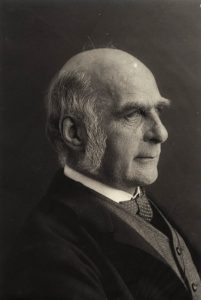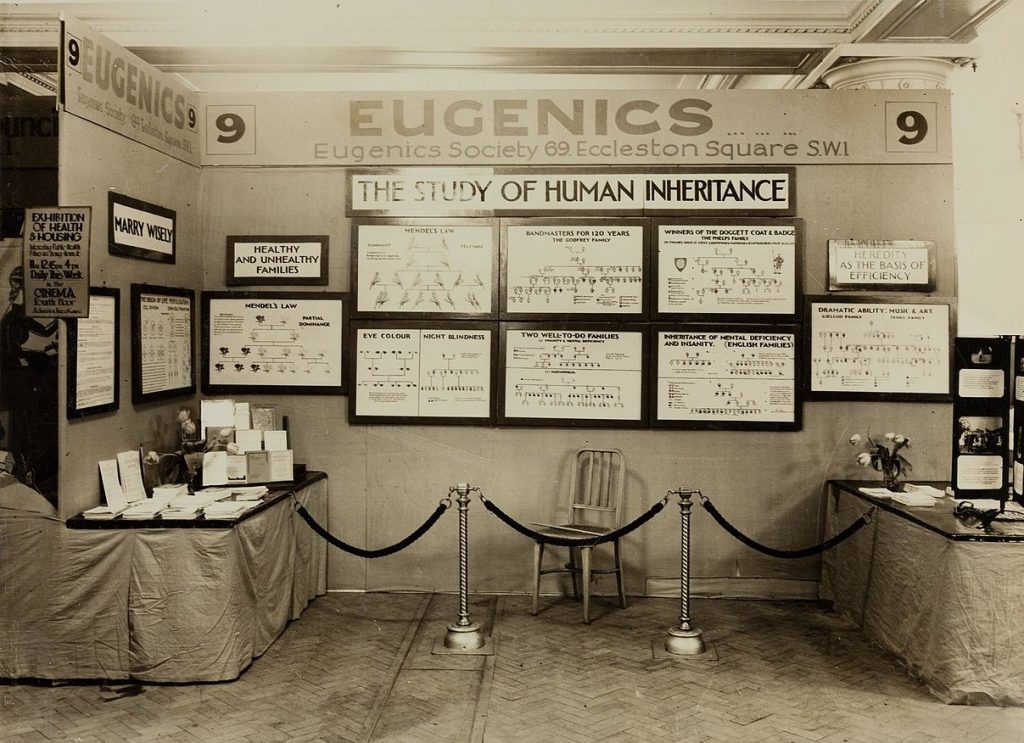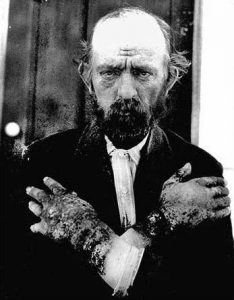—The biography of Charles Darwin’s cousin allows ‘uncomfortable’ episodes in the history of biology to be explored.—
Francis Galton (1822-1911) was a multifaceted author, a polymatist who wrote on many topics, including meteorology, anthropology, heredity, statistics, psychology, eugenics and criminology. Charles Darwin’s cousin, Galton had a somewhat disoriented youth. He studied medicine and ended up graduating in mathematics at the University of Cambridge, without especially standing out for his academic results. His father’s death in 1844 provided him with more than significant financial security and he was able to enjoy his interest in adventure, travelling around the Middle East, exploring Africa and investigating weather patterns. His cousin Charles’ publication On the Origin of Species transformed his intellectual life. He turned his attention to problems of human biology, including heredity, psychology, anthropometry and development. He showed a great passion for measuring and quantifying, and in pursuing this passion, ended up making important contributions to statistics.
With works such as Hereditary Talent and Character (1865) he argued that intellectual, moral and personality characteristics are passed down from parents to children. His interest in these issues continued and, in 1883, he coined the term ‘eugenics’, which would be so successful among biologists in the late nineteenth and early twentieth centuries. According to deeply ideological criteria, Galton differentiated between lower and upper members of the population and proposed encouraging the reproduction of the latter to prevent the degeneration of humanity. He had found that the ‘inferior’ individuals – those who could be set within the working classes – reproduced much more effectively than the members of the upper classes that Galton described as ‘superior’. In this context, and following the evolutionary approaches of his cousin Charles, Galton concluded that humanity was in a process of degeneration, in such a way that future generations would be more marked by the characteristics of the inferior groups. He published works aimed at the general public to cause alarm about this situation and demanded consideration and action from the public authorities. However, his eugenic ideas never reached the dimension of state biosocial programmes that would lead to the forced sterilisation of thousands and thousands of people, as happened not only in Nazi Germany but also in the US, Sweden and many other places. Even so, his historical identity has been closely linked to these initiatives and, therefore, it is possible that those working in biology have developed a kind of ‘collective amnesia’ with respect to Francis Galton, as historians such as Robert Proctor have stated.

Francis Galton (1822-1911). Wikipedia.
However, the harshest expression of eugenics, the one that generated so much suffering, although later than Galton, cannot be easily isolated from either his publications or the development of life sciences and their subsequent molecularisation. Both the theory of evolution and that of heredity developed in clear connection with eugenic ideas. The relationship between evolutionism and eugenics is multidimensional. Eugenics is certainly not only derived from Darwinist evolutionism, but it is rooted in theories originating in the social sciences, such as those of political economy. However, it is no less true that Darwin’s evolutionary theory drew from those same social sciences. In its development, authors such as Herbert Spencer and Thomas Malthus were very influential, although Darwin avoided explicitly referring to humans in On the Origins of Species. On the other hand, Darwin himself, in later works, such as in The Descent of Man, discussed and accepted the eugenic ideas of authors such as Galton. This interest in associating evolutionism and eugenics persisted among many of his closest colleagues and even in his own son, Leonard Darwin. The latter was not only interested in the convergence of evolutionism and eugenics, but also in that which would occur between these and the genetics of the early twentieth century, and thus, he had a direct influence on the thinking of Ronald Aylmer Fischer and on the modern synthesis of evolutionism.
The development of the theory of evolution cannot be understood without considering the interest that eugenics awakened and the research it motivated. Something similar happened in the origins of classical genetics at the beginning of the twentieth century. Essential authors for the development of genetics, such as the British William Bateson, identified with eugenic approaches and, on the other hand, cutting-edge centres for the study of genetics, such as the Cold Spring Harbor Laboratory in the USA, or the German Kaiser Wilhelm Institutes (KWI), specifically that of Psychiatry and Anthropology, Human Heritage and Eugenics, were especially active in eugenic research during the first decades of the twentieth century. Perhaps the case of the KWI is the best known and, as they were linked to Nazism, that close link between genetic or biological research and eugenics was to be expected. However, it is important to remember that the Eugenics Record Office was created in the Cold Spring Harbor Laboratory, a leading centre for genetic research, in 1910, dedicating important efforts to eugenic research for more than two decades. During its first decades of existence, the centre was directed by Charles B. Davenport (1866-1944), with whom Galton’s biography is once again intertwined.

Eugenics Society exhibition circa 1930s. Wikimedia.
Davenport spent part of a sabbatical year (1899-1900) in London with Galton and his protégé Karl Pearson, returning to America determined to implement the eugenic research of which he had learned so much during his stay in London. In this way, he promoted the creation of the Eugenics Record Office, for which he obtained funding from the Carnegie Institution of Washington and other private patrons. Thus, a centre that had a great influence in very diverse areas of the social, migratory and scientific policy of the United States of America opened its doors. However, if one of the pillars of the centre’s activity was the spread of eugenic ideas and the promotion of legislation and policies in accordance with them, scientific research constituted the other fundamental pillar. This research, from 1935, was criticised and considered of little interest for the development of genetics, but in its first years of existence it was regularly considered in accordance with international quality standards. This was the case of the research on the heredity of colour blindness, polydactyly or Hungtinton’s disease, among others, developed at the centre.

Person affected by pellagra. Wikipedia.
Class or racial biases could be more easily observed in the research focused on ‘characters’ such as alcoholism, crime or poverty, which progressively took on more prominence. However, even that early research that did not focus on moral or intellectual ‘characters’ was subject to a reductionist ideology that prevailed for much of the development of the biological sciences in the twentieth century. Thus, for example, Davenport carried out studies on the hereditary nature of pellagra without taking into account the environmental factors with which the disease was already identified at that time and which would soon be corroborated. The presence of numerous cases in multiple generations of certain families led him to search for the genetic origin of the disease and, in contrast, he did not perceive the persistence of poor nutrition in these families, which, in fact, explained the disease. Today we would have no difficulty in identifying the deficiencies of that eugenic science, but at that time its research could be carried out perfectly normally in privileged centres of international science.
Many publications catalogue eugenics or social Darwinism as ‘pseudoscientific’ theories, thus erasing the place that these approaches had in academic science during its first decades of its development. In these publications, it is inevitable to perceive a desire to ‘clean up’ the good image of the biological sciences. However, the analysis of the historical development of eugenics, discussed in this section, shows changing and complex situations, within which it is difficult to precisely establish the limits of science and the various ways of accommodating eugenics within the scientific community. The example shows that the use of the qualifier ‘pseudoscientific’ in the history of science is usually loaded with both presentist condescension and a desire to move away from an uncomfortable past.
Ximo Guillem Llobat
IILP-UV
How to cite this paper:
Guillem Llobat, Ximo. Francis Galton and eugenics. Sabers en acció, 2021-01-27. https://sabersenaccio.iec.cat/en/francis-galton-and-eugenics/.
Find out more
You can find further information with the bibliography and available resources.
Recommended reading
Gillham, Nicholas Wright. A Life of Sir Francis Galton: From African Exploration to the Birth of Eugenics. Oxford: Oxford University Press; 2003.
Kevles, Daniel J. In the Name of Eugenics. Genetics and the Uses of Human Heredity. Cambridge (Massachusetts): Harvard University Press; 1998.
Paul, Diane. Darwin, social Darwinism and eugenics. In: Hodge, Jonathan; Radick, Gregory, eds. The Cambridge companion to Darwin. Cambridge: Cambridge University Press; 2003: 214-239.
Studies
Adams, Mark B.; Allen, Garland E.; Weiss, Sheila Faith. Human Heredity and Politics: A Comparative Study of the Eugenics Record Office at Cold Spring Harbor (United States), the Kaiser Wilhelm Institute for Anthropology, Human Heredity, and Eugenics (Germany), and the Maxim Gorky Medical Genetics Institute (USSR). Osiris. 2005; 20: 232-262.
Álvarez Peláez, Raquel. Sir Francis Galton, padre de la eugenesia. Madrid: Centro de Estudios Históricos; 1985.
Bashford, Alison; Levine, Phillipa. The Oxford handbook of the history of eugenics. Oxford: Oxford University Press; 2010.
Gillham, Nicholas Wright. A Life of Sir Francis Galton: From African Exploration to the Birth of Eugenics. Oxford: Oxford University Press; 2003.
Hawkins, Mike. Social Darwinism in European and American thought, 1860-1945: Nature as model and nature as threat. Cambridge: Cambridge University Press; 1997.
Kevles, Daniel J. From Eugenics to Genetic Manipulation. In: Krige, John; Pestre, Dominique, eds. Science in the twentieth century. Amsterdam: Harwood Academic Publishers; 1997, p. 301-318.
Kevles, Daniel J. In the Name of Eugenics. Genetics and the Uses of Human Heredity. Cambridge (Massachusetts): Harvard University Press; 1998.
Paul, Diane. Reflections on the Historiography of American Eugenics: Trends, Fractures, Tensions. Journal of the History of Biology. 2016; 49: 641-658.
Paul, Diane. Darwin, social Darwinism and eugenics. In: Hodge, Jonathan; Radick, Gregory, eds. The Cambridge companion to Darwin. Cambridge: Cambridge University Press; 2003: 214-239.
Proctor, Robert N.; Schiebinger, Londa. Agnotology: the making and unmaking of ignorance. Stanford: Stanford University Press; 2008.
Renwick, Chris. Eugenics, Population Research, and Social Mobility Studies in Early and Mid-Twentieth-Century Britain. The Historical Journal. 2016; 59: 845-867.
Snake, Norberto. More than a Mentor: Leonard Darwin’s Contribution to the Assimilation of Mendelism into Eugenics and Darwinism. Journal of the History of Biology. 2016; 49: 461-494.
Turda, Marius. Modernism and eugenics. New York: Palgrave Macmillan; 2010.
Sources
Websites and other resources
The Carter Center. Disease considered as candidates for global eradication by the International Task Force for Disease Eradication [Updated 25 January 2016; accessed 10 July 2020]. Available here.
The College of Physicians of Philadelphia. The History of Vaccines. Eradication of a disease [Updated 25 January 2018; accessed 10 July 2020]. Available here.



